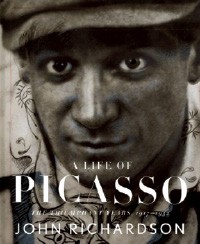You’ve got an A-list of book lovers to give to this Xmas, but you’re already short of ideas? Don’t be. It’s easy as ABC. Here you go: “A” is for art history and astronomy, Abe Lincoln and Alice Waters. “B” is for bacon, Balenciaga, the Bible, and bird songs. “C” is for cartography and craftsmanship.
That family member or friend with an interest in art history? Good chance he or she is familiar with the first two volumes of John Richardson’s biography of Pablo Picasso. Volume three, A Life of Picasso: The Triumphant Years, 1917-1932 (Knopf, $40), is now in stores. Look for it. Stargazers, look up. Starfinder (DK Publishing, $30) is a practical guide to navigating the night sky. Comes complete with maps and a flashlight for viewing the stars; comes with moon maps and a guide to the planets if you’re sticking closer to home: our very own solar system. From DK Publishing too and for that fan of all things Lincoln, see Lincoln: The Presidential Archives ($40) by Chuck Wills. It’s a biography, but it’s also a storehouse of reproduced notes and sketches. Vellum envelopes contain added treasures, including a facsimile of Lincoln’s handwritten Emancipation Proclamation. Go back about a hundred years, and you reach 1776. So reach for 1776: The Illustrated Edition (Simon & Schuster, $65), a new edition of David McCullough’s hugely popular history of the American revolution. The book comes with its own set of reproductions, maps, portraits, and what’s more: more vellum envelopes containing facsimiles of primary documents. And speaking of revolutionary … Alice Waters is at it again in The Art of Simple Food: Notes, Lessons, and Recipes from a Delicious Revolution (Clarkson Potter, $35).
While you’re at it in the kitchen … fry up a mess of bacon, be it the everyday variety or artisanal. James Villas — a Southerner by birth, an award-winning food writer by trade — knows how to bring home the bacon, a world of bacon, in The Bacon Cookbook (Wiley, $35), a title that Gourmet magazine just named one of the best cookbooks of the year. The years 1947 to 1957? It may have been a lean postwar decade in Europe, but in Paris and London it was a golden age for Balenciaga and Balmain, Dior and Givenchy. Richard Avedon and Cecil Beaton caught it on film. See for yourself in the pages of The Golden Age of Couture: Paris and London 1947-1957 (Victoria and Albert Museum, $45), edited by Claire Wilcox. Then settle down with another book — the good book: the Bible. But have at hand Karen Armstrong’s The Bible: A Biography (Atlantic Monthly Press, $21.95), a scholarly but readable history of who wrote the Bible and when and a history of biblical interpretation, be it by Jew or gentile. The word for Armstrong: brilliant. But that sound you hear … it’s bird song, and it’s coming from Bird Songs From Around the World (Chronicle Books, $45) by Les Beletsky. It comes with its own built-in digital audio player, and it contains a description of the over 200 songbirds sampled. The world’s within earshot.
The world’s at your fingertips in Cartographia: Mapping Civilizations (Little, Brown, $60). Authored by Vincent Virga and drawn from the collection of the Library of Congress, Cartographia offers an outstanding array of 200 of the most beautiful and important maps the world has known, and that includes imaginary territory: a 17th-century map of the “soul” and William Faulkner’s hand-drawn map of Yoknapatawpha County, Mississippi. Two hundred is the number too in Craft in America: Celebrating Two Centuries of Artists and Objects (Clarkson Potter, $60) by Jo Lauria and Steve Fenton — two centuries in 200 images of signature objects in wood, ceramic, glass, fabric, and metal, from Native Americans to African Americans to Shakers to contemporary artists. Make it or any book from you to a loved one this Christmas. — Leonard Gill
Happy Hanukkah?

Let’s face it: The potato is extraordinarily ordinary, even when it’s baked, fried, mashed, or shaped into pancakes called latkes with a little onion and salt. So how did this workhorse of the Jewish kitchen take center stage for the celebration of Hanukkah in The Latke Who Couldn’t Stop Screaming (McSweeney Books, $9.95)?
Kicking and screaming in a pan of hot oil, that’s how, then leaping out a kitchen window into a snowy night for a break beneath a pine tree, too weary to compete with the glitz of Christmas. Happily, this misunderstood latke finds peace and purpose with a family who knows that “different things can often blend together,” much like Lemony Snicket’s holiday storytelling and the infectious illustrations of Lisa Brown. — Pamela Denney

Got a dog- and book-lover on your Xmas list?
Memphian Jack Kenner’s Dogs I’ve Nosed is a collection of Kenner’s photographs of Memphis dogs (all shapes, all sizes), with a few shots thrown in of the owners too, including Cybill Shepherd, proud owner of not one but two German shepherds. For the record (and for the book’s cover): That’s Murphy and Winston (above), Kenner’s own West Highland terriers.
axmen
“Only a Gibson is good enough.”
That was the guitar company’s slogan for years, and for countless musicians around the world, they were right. More than half a century after tinkerers at different companies finally coaxed tunes from an electrified guitar, most performers have still banded together into three fiercely loyal camps: Gibson enthusiasts, Fender fans, and all the rest.
The Gibson Electric Guitar Book (Backbeat Books, $24.95), written by former Gibson Company historian Walter Carter, presents the Gibson side of the “guitar wars,” but it’s not the glowing advertisement you might expect. The author makes that clear from the beginning: “Gibson did not invent the electric guitar and did not invent the solid-body electric guitar (nor did Les Paul).”
Those words might be considered sacrilege coming from anybody else, but Carter presents a detailed — and accurate — history of the development of rock-and-roll’s signature instrument, giving credit where credit is due.
With all its high-tech talk about humbuckers, patent-applied-for pickups, and other gizmos, this book may not appeal to beginners. But it does present an excellent, decade-by-decade overview of Gibson’s classic products, eye-catching designs, and technical contributions. The photos of such classics as a mint-condition 1952 Les Paul or a 1961 “reverse body” Firebird are enough to make any collector drool. — Michael Finger